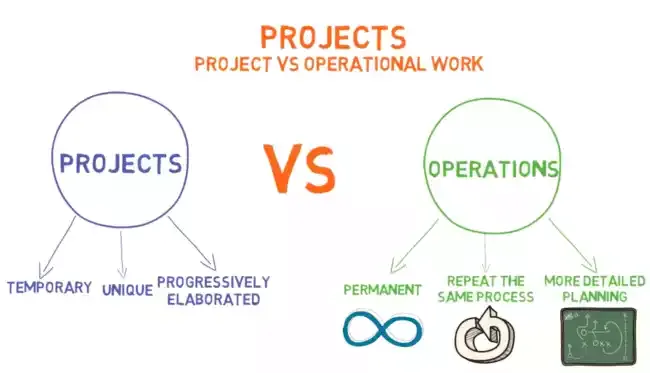What is Difference Between Project and Operation, because you will be taking the PMP exam, it is critical that you understand the project, the operation, and the differences between these two terms.
On the PMP exam, you may be asked to identify whether a person is performing project work or operational tasks based on a scenario.
Many individuals get these two concepts confused, presumably because they share the following characteristics:
- Both are performed by people.
- Both are planned, executed, Monitored and controlled.
- Both have resource limitations.
What is a project?
"A project is a temporary endeavor undertaken to create a unique product, service, or result," according to the PMBOK Guide. The project's nature is transient, as stated in the first point. This implies that your project will end when you deliver the desired outcome. The goal has been accomplished.
The project generates a particular output, which brings us to our second point. If it is a construction-related project, it may create a physical structure. If it is a research-related project, it may produce a report, like an analysis of vehicle pollution’s impact on the environment.
A project may also produce a service-related output, like setting up a call center to help customers solve their problems.
What is an operation?
- Operations are the continuous carrying out of tasks that result in a repeatable product or service.
- While operations don't create anything new, they are required to keep a system functioning.
- Operations are utilized to maintain the firm, run regular business models, and accomplish goals.
- The organization's profit is the sole thing limiting operations, which are ongoing.
- An operation can be any kind of production or manufacturing process.
The difference between the project and the operation
- Operations are the continuous carrying out of tasks that result in a repeatable product or service.
- While operations don't create anything new, they are required to keep a system functioning.
- Operations are utilized to maintain the firm, run regular business models, and accomplish goals.
- The organization's profit is the sole thing limiting operations, which are ongoing.
- An operation can be any kind of production or manufacturing process.
Quiz - Exam Preparation
Question 1: What is the primary difference between an operation and a project?
A) Operations are temporary, while project are ongoing
B) Operation have deadlines, while project do not
C) Operations produce the same thing repeatedly, while project do not
D) Operations are completed, while project are ongoing
Explanation for the best answer: C) Operations produce the same thing repeatedly, while projects do not. In the lecture, it is mentioned that an operation involves ongoing work where the same thing is produced repeatedly, whereas projects are temporary and have defined endpoints.
Question 2: In the context of Project Management Offices (PMOs), which type of PMO has the highest authority?
A) Supportive PMO
B) Controlling PMO
C) Directive PMO
D) PMOs have equal authority
Explanation for the best answer: C) Directive PMO. Directive PMOs not only coordinate but also directly manage projects, making them the most powerful type of PMO with the highest authority.
Question 3: What does Organizational Project Management (OPM) provide guidance for?
A) Project Management only
B) Program Management only
C) Project Management, Program Management, Operation Management & Portfolio Management
D) Project Management, Program Management, & Portfolio Management
Explanation for the best answer: C) Project Management, Program Management, Operation Management, and Portfolio Management. OPM provides guidance for all organizational works, including Project Management, Program Management, Operation Management, and Portfolio Management.
Question 4: What is the main purpose of Organizational Governance?
A) To define the strategic framework for project management
B) To provide policies and processes for project teams
C) To meet high-level strategic goals of the organization
D) To implement project governance within the organization
Explanation for the best answer: C) To meet high-level strategic goals of the organization. Organizational Governance aims to meet high-level strategic goals of the organization by providing a high-level roadmap that includes procedures, standards, and policies.
Question 5: What is the relationship between a Project Management Office (PMO) and Project Governance?
A) PMO provides project governance
B) Project governance provides support to PMO
C) PMO & project governance are not related
D) Project governance controls the PMO
Explanation for the best answer: A) PMO provides Project Governance. Project Governance provides the project team with policies, processes, decision-making models, and tools to manage the project, and a Project Management Office (PMO) may provide and implement Project Governance.
Question 6: Which type of Project Management Office (PMO) has the least authority over projects?
A) Support PMO
B) Controlling PMO
C) Directive PMO
D) PMOs have equal authority
Explanation for the best answer: A) Supportive PMO. Supportive PMOs have the least authority over projects compared to Controlling PMOs and Directive PMOs. They mainly provide standards, procedures, and support for projects, but they don't have much responsibility for project control and direction.
Report Card
Total Questions Attempted: 0
Correct Answers: 0
Wrong Answers: 0
Percentage: 0%
Tags:



